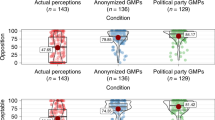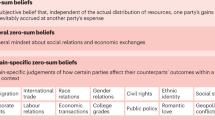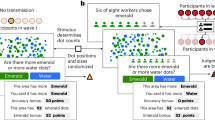Abstract
How do we evaluate a group of people after a few negative experiences with some members but mostly positive experiences otherwise? How do rare experiences influence our overall impression? We show that rare events may be overweighted due to normative inference of the hidden causes that are believed to generate the observed events. We propose a Bayesian inference model that organizes environmental statistics by combining similar events and separating outlying observations. Relying on the model’s inferred latent causes for group evaluation overweights rare or variable events. We tested the model’s predictions in eight experiments where participants observed a sequence of social or non-social behaviours and estimated their average. As predicted, estimates were biased toward sparse events when estimating after seeing all observations, but not when tracking a summary value as observations accrued. Our results suggest that biases in evaluation may arise from inferring the hidden causes of group members’ behaviours.
This is a preview of subscription content, access via your institution
Access options
Access Nature and 54 other Nature Portfolio journals
Get Nature+, our best-value online-access subscription
$29.99 / 30 days
cancel any time
Subscribe to this journal
Receive 12 digital issues and online access to articles
$119.00 per year
only $9.92 per issue
Buy this article
- Purchase on Springer Link
- Instant access to full article PDF
Prices may be subject to local taxes which are calculated during checkout




Similar content being viewed by others
Data availability
The data that support the findings of this study are available at https://osf.io/fdcvw.
Code availability
Custom code that supports the findings of this study is available from the corresponding author upon request.
References
Rozin, P. & Royzman, E. B. Negativity bias, negativity dominance, and contagion. Personal. Soc. Psychol. Rev. 5, 296–320 (2001).
Fiske, S. T. Attention and weight in person perception: the impact of negative and extreme behavior. J. Pers. Soc. Psychol. 38, 889–906 (1980).
Pearce, J. M. & Hall, G. A model for Pavlovian learning: variations in the effectiveness of conditioned but not of unconditioned stimuli. Psychol. Rev. 87, 532–552 (1980).
Mende-Siedlecki, P., Cai, Y. & Todorov, A. The neural dynamics of updating person impressions. Soc. Cogn. Affect. Neurosci. 8, 623–631 (2013).
Alves, H., Koch, A. S. & Unkelbach, C. The ‘common good’ phenomenon: why similarities are positive and differences are negative. J. Exp. Psychol. Gen. https://doi.org/10.1037/xge0000276 (2017).
Unkelbach, C., Fiedler, K., Bayer, M., Stegmüller, M. & Danner, D. Why positive information is processed faster: the density hypothesis. J. Pers. Soc. Psychol. 95, 36–49 (2008).
Alves, H. et al. A density explanation of valence asymmetries in recognition memory. Mem. Cogn. 43, 896–909 (2015).
Alves, H., Koch, A. S. & Unkelbach, C. A cognitive–ecological explanation of intergroup biases. Psychol. Sci. 29, 1126–1133 (2018).
Courville, A. C., Daw, N. D. & Touretzky, D. S. in Advances in Neural Information Processing Systems 17 (eds Saul, L., Weiss, Y. & Bottou, L.) 313–320 (MIT Press, 2005).
Gershman, S. J., Blei, D. M. & Niv, Y. Context, learning, and extinction. Psychol. Rev. 117, 197–209 (2010).
Gershman, S. J. & Niv, Y. Learning latent structure: carving nature at its joints. Curr. Opin. Neurobiol. 20, 251–256 (2010).
Austerweil, J. L. & Griffiths, T. L. A nonparametric Bayesian framework for constructing flexible feature representations. Psychol. Rev. 120, 817–851 (2013).
Eyal, T., Hoover, G. M., Fujita, K. & Nussbaum, S. The effect of distance-dependent construals on schema-driven impression formation. J. Exp. Soc. Psychol. 47, 278–281 (2011).
Morey, R. D., Rouder, J. N. and Jamil, T. BayesFactor package https://richarddmorey.github.io/BayesFactor/ (2015).
Rouder, J. N. & Morey, R. D. A Bayes factor meta-analysis of Bem’s ESP claim. Psychon. Bull. Rev. 18, 682–689 (2011).
Alves, H., Koch, A. S. & Unkelbach, C. Why good is more alike than bad: processing implications. Trends Cogn. Sci. 21, 69–79 (2017).
Kahneman, D. & Tversky, A. Prospect theory: an analysis of decision under risk. Econometrica 47, 263–291 (1979).
Denrell, J. Why most people disapprove of me: experience sampling in impression formation. Psychol. Rev. 112, 951–978 (2005).
Siegel, J. Z., Crockett, M. J. & Dolan, R. J. Inferences about moral character moderate the impact of consequences on blame and praise. Cognition 167, 201–211 (2017).
Ito, T. A. & Cacioppo, J. T. Variations on a human universal: individual differences in positivity offset and negativity bias. Cogn. Emot. 19, 1–26 (2010).
Hamilton, D. L. & Sherman, S. J. Perceiving persons and groups. Psychol. Rev. 103, 336–355 (1996).
Asch, S. E. Forming impressions of personality. J. Abnorm. Soc. Psychol. 41, 258–290 (1946).
Jones, E. E. & Davis, K. E. in Advances in Experimental Social Psychology Vol. 2 (ed. Berkowitz, L.) 219–266 (Academic Press, 1965).
Fiske, S. T. & Neuberg, S. L. in Advances in Experimental Social Psychology Vol. 23 (ed. Zanna, M. P.) 1–74 (Academic Press, 1990).
Smith, E. R. & Zárate, M. A. Exemplar-based model of social judgment. Psychol. Rev. 99, 3–21 (1992).
Campbell, D. T. Common fate, similarity, and other indices of the status of aggregates of persons as social entities. Behav. Sci. 3, 14–25 (1958).
Lickel, B. et al. Varieties of groups and the perception of group entitativity. J. Pers. Soc. Psychol. 78, 223–246 (2000).
Reed, S. K. Pattern recognition and categorization. Cogn. Psychol. 3, 382–407 (1972).
Nosofsky, R. M. Attention, similarity, and the identification–categorization relationship. J. Exp. Psychol. Gen. 115, 39–57 (1986).
Hilton, J. L. & von Hippel, W. Stereotypes. Annu. Rev. Psychol. 47, 237–271 (1996).
Sanborn, A. N., Griffiths, T. L. & Navarro, D. J. Rational approximations to rational models: alternative algorithms for category learning. Psychol. Rev. 117, 1144–1167 (2010).
Zhang, H. & Maloney, L. T. Ubiquitous log odds: a common representation of probability and frequency distortion in perception, action, and cognition. Front. Neurosci. 6, 1 (2012).
Merten, K. & Nieder, A. Compressed scaling of abstract numerosity representations in adult humans and monkeys. J. Cogn. Neurosci. 21, 333–346 (2008).
Dehaene, S., Dehaene-Lambertz, G. & Cohen, L. Abstract representations of numbers in the animal and human brain. Trends Neurosci. 21, 355–361 (1998).
Wagenmakers, E. J. et al. Bayesian inference for psychology. Part I: theoretical advantages and practical ramifications. Psychon. Bull. Rev. 25, 35–57 (2018).
Aldous, D. J. in Exchangeability and Related Topics 1117 (ed. Hennequin, P. L.) 1–198 (Springer, 1985).
Shepard, R. N. Toward a universal law of generalization for psychological science. Science 237, 1317–1323 (1987).
Tenenbaum, J. B. & Griffiths, T. L. Generalization, similarity, and Bayesian inference. Behav. Brain Sci. 24, 629–640 (2001).
Fearnhead, P. Particle filters for mixture models with an unknown number of components. Stat. Comput. 14, 11–21 (2004).
Acknowledgements
This work is supported by grant number W911NF-14-1-0101 from the Army Research Office and grant R01DA042065 from the National Institute of Drug Abuse. The funders had no role in study design, data collection and analysis, decision to publish or preparation of the manuscript. The authors are grateful to S. DuBrow and A. Radulescu for comments on an earlier draft.
Author information
Authors and Affiliations
Contributions
Y.S.S. and Y.N. designed the study. Y.S.S. ran the experiment. Y.S.S. and Y.N. analysed the data and wrote the manuscript.
Corresponding author
Ethics declarations
Competing interests
The authors declare no competing interests.
Additional information
Peer review information Primary Handling Editors: Marike Schiffer; Mary-Elizabeth Sutherland.
Publisher’s note Springer Nature remains neutral with regard to jurisdictional claims in published maps and institutional affiliations.
Supplementary information
Supplementary Information
Supplementary Figs. 1–3.
Rights and permissions
About this article
Cite this article
Shin, Y.S., Niv, Y. Biased evaluations emerge from inferring hidden causes. Nat Hum Behav 5, 1180–1189 (2021). https://doi.org/10.1038/s41562-021-01065-0
Received:
Accepted:
Published:
Issue Date:
DOI: https://doi.org/10.1038/s41562-021-01065-0
This article is cited by
-
How inferred motives shape moral judgements
Nature Reviews Psychology (2022)
-
Latent motives guide structure learning during adaptive social choice
Nature Human Behaviour (2021)



